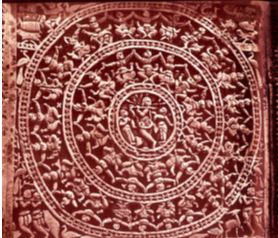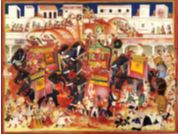The Making of Regional Cultures - Worksheets
CBSE Worksheet 01
The Making of Regional Cultures
- Which of the following is false
- The Chera kingdom of Mahodayapuram was established in the ninth century in the south-western part of the peninsula
- From the eighth century, Bengal became the centre of a regional kingdom under the Palas
- Mughal control over Bengal with their capital in the heart of the eastern delta at Dhaka
In 1230, king Anangabhima II dedicated his kingdom to the deity and proclaimed himself as the ?deputy? of the god
- Match the following
State
(a) Rajasthan
(b) West Bengal
(c) Lucknow
Place(1) Awadh
(2) Bankura
(3) Mewar- (a)-(2),(b)-(1),(c)-(3)
- (a)-(1),(b)-(2),(c)-(3)
- (a)-(2),(b)-(3),(c)-(1)
- (a)-(3),(b)-(2),(c)-(1)
Identify the following figure, what is seen in the figure

Krishna with gopis, Palm leave
Krishna with gopis, terracotta plaque
Ram with gopis, Wood plaque
Ram with gopis, terracotta plaque
- The earliest miniatures were on
- Glass
- Palm leaves or wood
- Plastic
- Paper
Identify the below miniature and what is seen in it

Rasamanjari playing holi
Akbar playing holi
Nadir Singh II playing holi
Maharana Ram Singh II playing holi
Match the following:
Column A Column B (i) Manipravalam (a) Cause for conflicts (ii) Folk plays (b) Diamonds and corals (iii) Anantavarman (c) Erected temple of Jagannatha (iv) Woman (d) Rasa Lila - Fill in the blanks:
Odissi is a popular classical dance of ________.
- State true or false:
Kathak was a caste of storytellers in temples of north India.
Why was the second category of the early Bengali literature not written down?
Where did Kathak develop?
Why do we know much more about the cultural practices of rulers than about those of ordinary people?
How did the tradition of kathak emerge?
How is Bengali literature divided?
CBSE Worksheet 01
The Making of Regional Cultures
Solution
- (d) In 1230, king Anangabhima II dedicated his kingdom to the deity and proclaimed himself as the? deputy? of the god Explanation: In 1230, King Anangabhima III dedicated his kingdom to the deity and proclaimed himself as the "deputy" of the god.
- (d) (a)-(3),(b)-(2),(c)-(1) Explanation: A. Mewar is a region of south-central Rajasthan state in western India
B. Bankura district is an administrative unit in the Indian state of West Bengal
C. Awadh known in British historical texts as Avadh is in Lucknow
- (b) Krishna with gopis, terracotta plaque Explanation: The given image is of Krishna with gopis, terracotta plaque from the Shyamaraya temple, Vishnupur.
- (b) Palm leaves or wood Explanation: The earliest miniatures were on palm leaves or wood. Some of the most beautiful of these, found in western India.
- (d) Maharana Ram Singh II playing holi Explanation: The given miniature is the Rajput Miniature of Maharana Ram Singh II playing Holi, Kota.
(i)-(b), (ii)-(d), (iii)-(c), (iv)-(a).
- Orissa
True
- The second category of the early Bengali literature was circulated orally and therefore it was not written down.
- Kathak developed in the courts of Rajasthan (jaipur) and Lucknow.
They adopted several methods to preserve their achievements. Stories about Rajput heroes were recorded in poems and songs, which were recited by specially trained minstrels. Rulers patronised highly skilled painters who primarily- illustrated manuscripts containing historical accounts and poetry. These were generally painted in brilliant colours and portrayed court scenes and other aspects of social life. Ordinary people did not do anything to preserve the records of their heroic deeds. The above-mentioned reasons clearly show why we know more about the cultural practices of rulers than those of ordinary people.
- The term ‘kathak’ is derived from the word “katha”, it is a Sanskrit word used for story and hence the word ‘kathak’ means a storyteller.
- The kathaks initially were a caste of storytellers in North Indian temples, whose performances was accompanied with gestures and songs.
- Kathak evolved as a distinct dance form in 15th and 16th century with the spread of the Bhakti movement.
- The legend of Radha-Krishan was enacted in folk plays known as Rasa-Lila.
The Bengali literature is divided into two groups:
- Bengali Owes its Origin to Sanskrit:
This includes translation of Sanskrit epics, the Mangalakavyas (poems dealing with local deities) and Bhakti literature like that of leaders of Vaishnava Bhakti movements like Chaitanyadeva. These texts are easily available as several manuscripts composed between the late 15th and mid-18th centuries have been found. - Bengali is Independent of Sanskrit:
This includes Nath literature like the songs of Maynamati and Gopichandra, stories dealing with the worship of Dharma Thakur and fairytales, folk tales and ballads. This source was popular in Eastern Bengal, where the influence of Brahmins was weak. This was circulated orally and has no precise date.
- Bengali Owes its Origin to Sanskrit:
